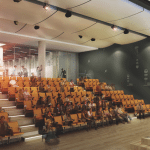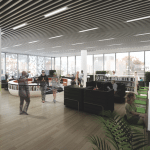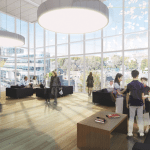From recording studios to a rooftop terrace, the new Halifax Central Library reflects the community’s desires
 Halifax librarian Alison Ambi demonstrates how she can control her laptop using leaves and twigs via MaKey MaKey, a microcontroller that acts like a remote keyboard when plugged into a computer. “Unfortunately, I didn’t have time to go grocery shopping,” says Ambi. Otherwise, she would be attaching strawberries to her laptop instead.
Halifax librarian Alison Ambi demonstrates how she can control her laptop using leaves and twigs via MaKey MaKey, a microcontroller that acts like a remote keyboard when plugged into a computer. “Unfortunately, I didn’t have time to go grocery shopping,” says Ambi. Otherwise, she would be attaching strawberries to her laptop instead.
Ambi’s office is tucked away in the reference section of downtown Halifax’s Spring Garden Road Memorial Library. For the past year she’s been part of Halifax Public Libraries’ emerging technologies department, experimenting with a host of gadgets, from robotics kits to 3D printers to conductive Playdough (adorably dubbed Squishy Circuits).
While construction workers across the street assemble the structure that will become Halifax’s new central library, Ambi and her colleagues have been preparing for what will happen inside the new $55-million, five-level, 108,000-square-foot building, slated to open this fall.
From 2008 to ’10, before breaking ground, HPL hosted five well-attended public consultations. “The teens very vocally said they wanted a workshop-like space,” says Ambi. And so, on the second floor of the new library, there will be a makerspace (dubbed the “Creative Lab”) for exploring everything from traditional crafts to electronics. There will also be two fully equipped recording studios, another public request that made it into the design.
These spaces represent a new dimension in what contemporary libraries are expected to provide. It’s not just about finding and appreciating a wealth of cultural resources anymore: it’s also about making and creating your own. Ultimately, Ambi says, libraries are still focused on learning. “For years libraries have been helping people learn how to use Microsoft Word and search the Internet,” she says. “Then we moved into ebooks and tablets. Later today I’m teaching someone how to use Skype. I see this as a progression from that.”
She adds, “The concept of how you learn is broadening. There’s more of a focus on learning by doing, tinkering, taking things apart.”
The boardroom of the Alderney Gate Library branch in Dartmouth looks onto a somewhat forlorn rooftop patio attached to HPL’s administrative offices. The new building will also feature a rooftop terrace, but according to Halifax Central Library director Bruce Gorman, the best spaces will be reserved for the public, another demand from the extensive consultation process.
“We put in exactly the things the community said they wanted,” he says. “For us, definitely, that was a leap. It was a new way of doing things.”
The choice of architects for the project also represents a new way of working. In 2010, Danish firm Schmidt Hammer Lassen Architects was awarded the $45 million contract via an international competition, collaborating with local partners Fowler Bauld & Mitchell.
The architectural team conceived a striking stack-of-books design, which was flagged by CNN as one of 10 “eye-popping new buildings that you’ll see in 2014.” Gorman thinks the open-concept glass building will become a Halifax icon, but what he’s really excited about is what will happen inside.
“We’re about third spaces,” says Gorman, describing a place outside of home and work, where you can go and “make it the space that you want.”
With plenty of multi-functional areas located throughout the building, the highlight is the fifth floor, featuring the rooftop terrace, a café, and the Halifax Living Room, a soft-seating lounge overlooking bustling Spring Garden Road.
This is the role of the modern library, says Gorman. Out in the world, “there’s less and less public space – social-equality space where you can make the space your own and no one is ever going to ask you to leave,” he says. The new central branch will offer “a real new value proposition for what libraries are in communities.”
Of course, libraries are still about books. The HPL collection will expand by 40 per cent and be equipped with radio-frequency I.D. chips to make checkouts and materials handling more efficient. Housing the collection will be an interesting proposition in a glass building, however. There won’t be rows of shelves near the glass walls. Instead, books will be housed in what Gorman calls “collection furniture” located throughout the library.
“The uniqueness of the building is driven by what people wanted in the building, and we gave them what they wanted,” says Gorman. Patrons will be able to find or create the space they want, even if that means heading up to the roof to watch the harbour. “The sunsets up there will be remarkable,” he says.
Building highlights:
This feature appeared in the July/August print edition (photos: Jeremy Foster/renderings courtesy of Halifax Public Libraries)








 Contact us via email
Contact us via email
